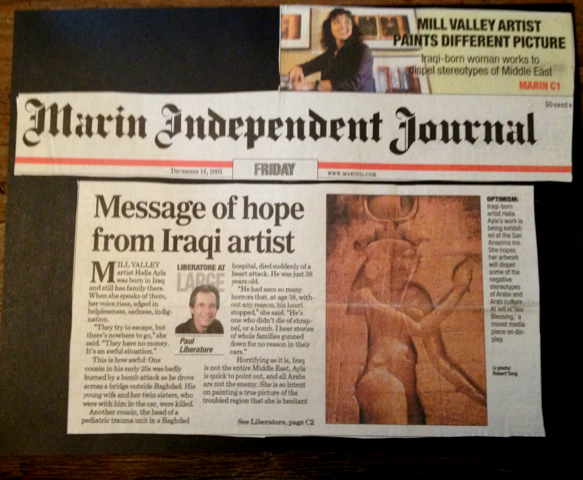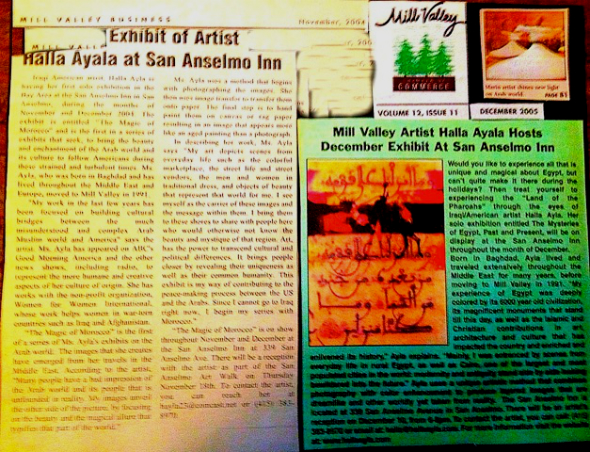ABC News Coverage of one of ‘The Arab World Unveiled’ Exhibitions.
![]()
STRIKING IMAGES OFFER FRESH PERSPECTIVE ON ARAB WORLD
By Andy Jones – Marin Scope October 2007
 When people come to see Iraqi-born artist Halla Ayla’s latest exhibit at the Essene Gallery in Sausalito, she hopes her mixed-media creations will be more than framed works of art to those who see them. Ayla hopes viewers will consider the 27 pieces on display to be windows into the often misunderstood world of Islamic and Arab culture.
When people come to see Iraqi-born artist Halla Ayla’s latest exhibit at the Essene Gallery in Sausalito, she hopes her mixed-media creations will be more than framed works of art to those who see them. Ayla hopes viewers will consider the 27 pieces on display to be windows into the often misunderstood world of Islamic and Arab culture.
Ayla’s new exhibit, “Everyday Enchantment,” is the third installment of her seven-part series “The Arab World Unveiled.” Each exhibit focuses on a particular Arab country or region. This one focuses on the region known as the Levant, an area that spans south from the Taurus Mountains to the northern Arabian Desert and eastward from the Mediterranean to the upper Mesopotamia region. Her art is further narrowed down to the parts of the Levant that fall in Lebanon, Jordan and Syria.
Ayla’s first two shows in the series were titled “The Magic of Morocco” and “The Mysteries of Egypt — Past and Present.”
The artist begins her projects with trips to the areas of focus and takes photographs using 35-mm and digital cameras. Ayla then uses the photos and a variety of techniques to create and layer the image, including Polaroid image transfer, encaustic painting and collage to create a mixed-media piece of work with a dreamlike quality.
“I’ll use calligraphy that is typical of the region, and I highlight architecture [the ancient city of Petra in Jordan is prominently featured in this exhibit],” Ayla said. “I try to capture the essence and soul of the place and people — capture it in a moment in time and space and hope that it will transmit.”
Ayla’s desire to transmit what she considers the real, authentic Middle East grew following the events of Sept. 11, 2001. Avoiding a political statement, Ayla decided to make art in order to counterbalance the negative portrayals of Islamic culture.
“A picture says a thousand words and I wanted to show the more enchanted, beautiful and more humane aspects,” Ayla said. “The idea is to build bridges between two worlds. People here are afraid because they don’t understand it. People in the Middle East are like everyone else: you’ve got to see the bigger picture rather than focusing on one smaller aspect.”
Ayla was living in Lebanon when that country’s civil war broke out in 1975. From there, she went to study in Paris, London and Geneva. She has lived in Mill Valley since 1991, creating art and raising a family along the way.
Ayla is realistic about the romanticism of a piece of art changing people’s image of a part of the world they don’t understand, but she said she hopes her work will initiate thought. “It opens the doors for more inquiry. I don’t have all the answers but I’m trying to demystify the place enough so that people will ask questions and not accept the often one-sided portrayal of things,” Ayla said. “Who knows what people end up taking with them from the show, but hopefully they’re interested and intrigued. I try to heal perception.” Ayla frequently visits the Middle East to see family members in Jordon and Syria, and other than war-torn Iraq (where other relatives still suffer in Baghdad) and embattled Palestine, she encourages others to visit the Middle East and experience it for themselves.
“I’m trying to say, Go there,” Ayla said. “I take friends to that part of the world and the Americans go crazy there, they love it. It’s so different, enchanted, the foods are different, sounds are different and the culture has so many dimensions. People miss out when they don’t go see certain places. People kind of throw the whole Middle East into a blob and say it’s scary, but for the most part, it’s not.”
Ayla said it’s hard to speak about a place or people when the information comes from television or books and magazines. And because of that, she said she has encountered some prejudice. “I’m not trying to be political. Some people are pro-Israeli or pro-military or what have you, I’m basically pro-human being,” Ayla said. “Injustice is injustice and I’m just trying to be a cultural ambassador.”
Ayla believes it’s easier to span gaps with art because it’s more universal in its appeal. “We could have a political discussion and disagree but if I say: ‘Do you like music? Do you like food? Do you like art?’ it makes it easier to build a bridge. I’ve chosen this medium because it’s a safe medium and it can allow people to lay down prejudice, at least long enough to give it a chance.”
While “Everyday Enchantment” will be on display through the beginning of January at Essene Gallery, Ayla also has exhibits planned in London, Paris, Geneva, Dubai, Beirut and Amman in 2008. Once she has completed the seven components of her series, she plans to release a book of images and stories from her travels to the Middle East. In the meantime, she’ll be releasing a new show every couple of years in order to create more windows of understanding between two very different cultures.
“We can’t heal the world by keeping ourselves separate,” Ayla said. “The differences are a cause for celebration instead of denigration.”
![]()
MESSAGE OF HOPE FROM IRAQI ARTIST

MILL VALLEY artist Halla Ayla was born in Iraq and still has family there. When she speaks of them, her voice rises, edged in helplessness, sadness, indignation.
“They try to escape, but there’s nowhere to go,” she said. “They have no money. It’s an awful situation.” This is how awful: One cousin in his early 20’s was badly burned by a bomb attack as he drove across a bridge outside Baghdad. His young wife and her twin sisters, who were with him in the car, were killed. Another cousin, the head of a pediatric trauma unit in a Baghdad hospital, died suddenly of a heart attack. He was just 38 years old. “He had seen so many horrors that, at age 38, without any reason, his heart stopped,” she said. “He’s one who didn’t die of shrapnel, or a bomb. I hear stories of whole families gunned down for no reason in their cars.”
Horrifying as it is, Iraq is not the entire Middle East, Ayla is quick to point out, and all Arabs are not the enemy. She is so intent on painting a true picture of the troubled region that she is hesitant to even use what she calls “the ‘T’ word,” meaning terrorism.
“There’s a lot of stereotyping that happens,” she said. “We need to change our imagery of that part of the world, rather than negate it and demonize it. Otherwise, it’s always going to be what we think it is, rather than what it really is. And that’s a big mistake. That part of the world is a hugely rich, colorful ancient civilization.”
As an antidote to the negative media images of Arab countries as dangerous, anti-American havens for terrorists and suicide bombers, Ayla creates images that, in her words, “focus attention on the more enchanting and intriguing aspects of the Arab and Islamic world and its people, aspects that so rarely see the light of day.”
“What I find is that a lot of people here in the U.S. have a set of images that they are exposed to repeatedly in the media,” she said. “What I try to do is present images in ways that are more comprehensive, so that people see a bigger picture, a larger perspective.”
Her latest exhibit, titled “Mysteries of Egypt, Past and Present,” is the second in a series she’s calling “The Arab World Unveiled.” It follows last year’s “The Magic of Morocco.”
Currently on display at the San Anselmo Inn are 23 photography-based mixed media pieces inspired by the golden aura of antiquity, of 5,500 years of Egyptian history.
Using photos that she has taken on her travels combined with hand coloring, painting and collage, Ayla reveals layered images of Sufi dancers, camels, pyramids, an Arabian horse, Arabic calligraphy, mystical portals and arches, mosques and mandalas.
“Through the subject matter, the saffron colors, the warmth, you can almost smell the Middle East and hear the call to prayer,” said Julie McNair, who owns the inn and has traveled extensively in Arab countries.
The 48-year-old Ayla was born in Baghdad into a Sunni family. She left Iraq in 1975 and lived in Lebanon, Saudi Arabia and Europe before settling in Marin County 15 years ago. She opposed the U.S. invasion and occupation of her native country, saying, “I don’t believe that war is the answer to anything.”
She has not returned to Iraq since she left, but she has traveled widely in the Middle East. She recently appeared on ABC’s “Good Morning America” to talk about her work with Women for Women International, an organization that helps women in war-torn countries.
Even in Marin, with its educated, affluent, well-traveled population, she encounters misconceptions about the Arab world, if not outright prejudice.
“I would have never thought it but, surprisingly, yes,” she said. “People who haven’t been there, which is the majority, will have that common perspective, which is really a shame. A lot of people ask, ‘Can I go there? It’s not scary?’ Actually, it’s much safer than anyone can imagine. The people are very warm, very kind to each other. It’s very different than people think it is. It has a lot to offer. That’s what I’m trying to say. Give it a chance.”

Marin Independent Journal

Mill Valley, CA